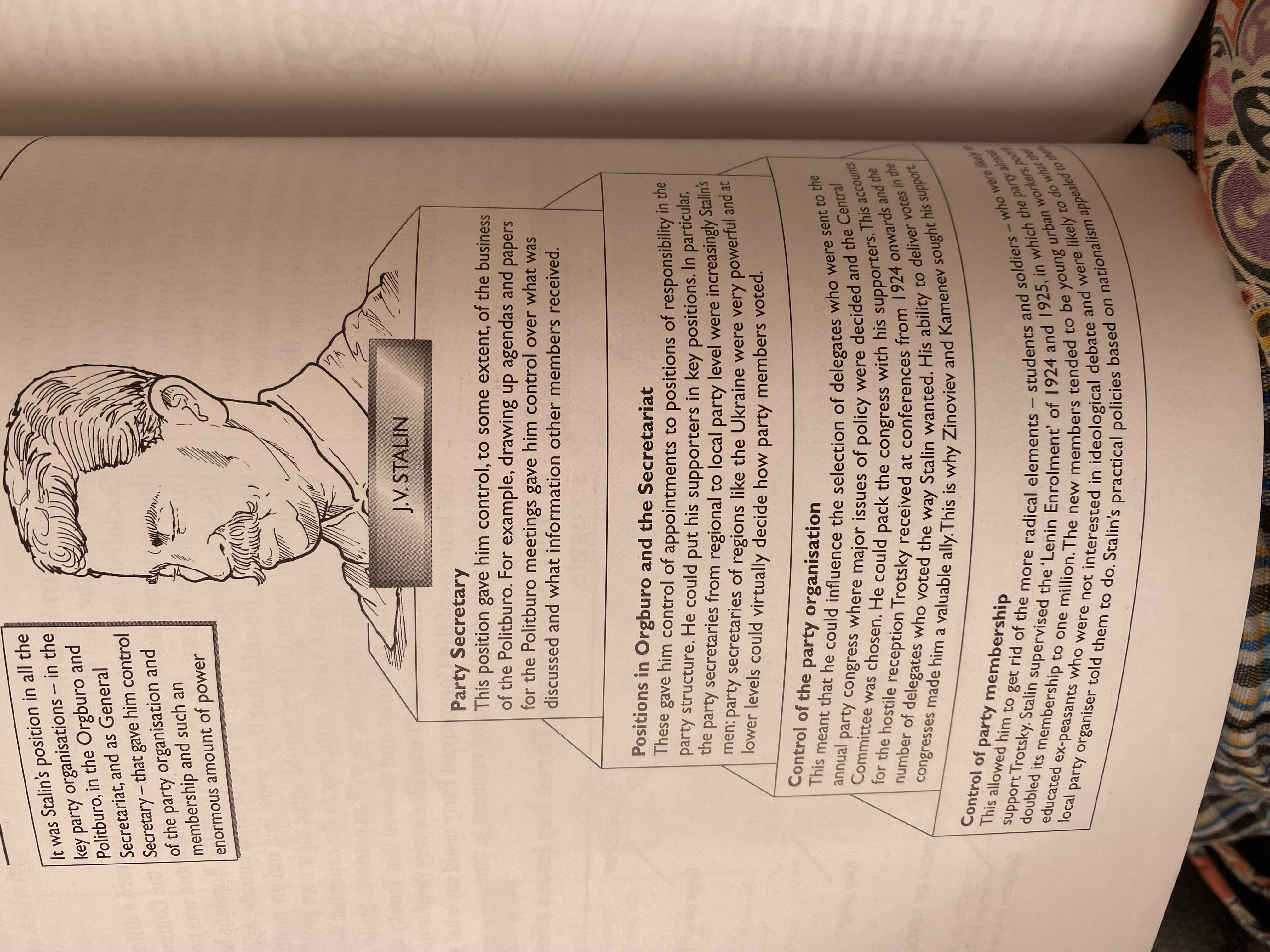the ideological debate
1/20
There's no tags or description
Looks like no tags are added yet.
Name | Mastery | Learn | Test | Matching | Spaced |
|---|
No study sessions yet.
21 Terms
lenins decling health
Multiple strokes from 1922 onwards incapacitated him; he died on 21 January 1924.
Permanent revolution
trotsky zinoviev and kamenev
continue NEP
Bukharin tomsky and Rykov
Early Power Struggle & “Triumvirate” (1924–1925)
A power bloc formed by Stalin, Zinoviev, and Kamenev to counter Trotsky.
13th Party Congress (May–June 1924): Stalin pushed his policy of “Socialism in One Country,” denouncing Trotsky’s Permanent Revolution as “petty-bourgeois deviation.” Lenin’s Testament remained unpublished, helping Stalin consolidate his position as General Secretary.
Defeating Trotsky
Trotsky outmaneuvered: His criticism of bureaucracy and absenteeism didn’t gain support. He lost his position as Commissar for War in January 1925,
United Opposition: In mid-1926, Trotsky, Zinoviev, and Kamenev formed the United Opposition. They were branded as factionalists. Stalin removed them from key posts; Trotsky was expelled from the Party in 1927, later exiled to Kazakhstan (1928) and deported (1929).
NEP and the great turn
NEP introduced by Lenin (1921–28):
Left Opposition (Trotsky, Zinoviev): NEP betrayed socialism; demanded rapid industrialisation.
Right (Bukharin, Rykov, Tomsky): Supported NEP continuation.
Stalin’s shift: Initially backed the Right, then pivoted to the Left’s ideas of forced industrialisation and collectivisation by late 1927–28
defeating the right
grain procurement crisis (1927–1929): Poor harvests led to food shortages, giving Stalin a pretext for grain requisitioning and collectivisation.
“Great Turn”: By 1928, Stalin reversed his stance and called for forced collectivisation and rapid industrialisation. He positioned Bukharin and the Right as “Right Communist” traitors.
1929 party congress
At the 1929 Party Congress, Bukharin lost key roles—Pravda editorship, Politburo, Comintern presidency; removed from office. By December 1929, Stalin was undisputed leader.
stalin as supreme leader
As General Secretary, Stalin placed loyalists in key positions and demoted opponents
Cult of personality: Propaganda portrayed Stalin as Lenin’s true heir, “Father of Nations,” erasing rivals from history.
ideological
Permanent Revolution (Trotsky) | Socialism in One Country (Stalin) |
|---|
Global socialist revolution needed for survival | USSR could build socialism alone |
Heavily revolutionary, internationalist | Pragmatic, nationalist, state‑led socialist development |
Aligned with Left Opposition | Adopted by Stalin, Zinoviev, Kamenev early; later Stalin as monopoly ideology |
large timeline
Lenin dies | 21 January 1924 |
13th Party Congress (Socialism in One Country vs Trotskyism) | May–June 1924 |
Trotsky loses Commissar for War post | January 1925 |
14th Party Congress (victory over New Opposition) | December 1925 |
United Opposition formed | Mid‑1926 |
Trotsky, Zinoviev, Kamenev expelled | 1927 |
Grain crisis & “Great Turn” | 1927–1928 |
First Five Year Plan begins | 1928 |
Trotsky exiled; Bukharin purged | 1928–1929 |
Stalin supreme leader | December 1929 |
why did stalin triumph
Control of party machinery: As General Secretary, he orchestrated promotions and purges, creating a loyal base.
Flexible ideology: Adopted whichever position best weakened opponents—first NEP to ally with the Right, then rapid industrialisation to discredit the Right.
Manipulating Lenin’s legacy: Suppressed his Testament; controlled funeral imagery and narratives.
Exploited crises: Food shortages, peasant resistance, and NEP failure provided pretexts for coercive measures.
The NEP in the 1920s
as the decade progressed the NEP became increasingly unattractive. the growth of a rich superclass,property dealing,gambling and land speculation - no place in socialism
1925-26 industry recovered to pre-1913 levels
high unemployment and food shortages started to reappear. peasants held onto produce
The funeral
-stalin tricked trotsky into not turning up at lenin’s funeral. severely damaging trotsky’s reputation and political prestige.
-he made the most of the funeral,setting himself up as Lenin’s disciple, the person who could carry on Lenin’s work
The united opposition
in 1926 zinoviev and kamenev joined trotsky to form a united opposition against stalin and made a direct appeal to party masses. however they could now be accused of “Factionalism” and all three of them lost their positions of power. in 1927 they were expelled from the party
timeline
1926 – Publication of On Questions of Leninism, where Stalin articulates “Socialism in One Country,” challenging Trotsky’s Permanent Revolution
October 1927 – Trotsky is removed from the Central Committee; he is exiled to Kazakhstan in 1928 and deported from the USSR in 1929
January 1928 – The grain procurement crisis begins, with Stalin blaming kulak “sabotage” — this crisis marks the shift from NEP to forced industrialisation
1928 – Launch of the First Five-Year Plan; Stalin begins collectivisation and pushes for rapid industrialisation
1928–1929 – Bukharin,is gradually removed from power — stripped of posts at Pravda, Comintern, and within the party. By 1929, he's fully purged from leadership
By December 1929 – Stalin stands as the undisputed leader of both party and state
Propaganda – From 1928–29, collectivisation and industrialisation are celebrated via state media; state control over press intensifies, the cult of personality intensifies, rewriting history and suppressing dissent begins
divide&conquer
Stalin first allied with Bukharin to isolate Trotsky, then reversed against Bukharin by exploiting the grain crisis—switching ideology as needed to outflank opponents
Stalins benefits

crsis exploitation
The 1927–28 grain procurement crisis became a tool to discredit Bukharin’s NEP approach and justify forced industrial and agricultural control
control & ideological shift
As General‑Secretary, Stalin staffed loyalists in key roles, manipulated party committees and publications (e.g. Pravda) to sway opinion
Ideological shift: His adoption and promotion of “Socialism in One Country” aligned him with nationalist sentiments and weakened Trotsky’s internationalist credibility
The winner
in december 1929 stalin celebrated his 50th birthday. He was now the undisputed leader of the ussr